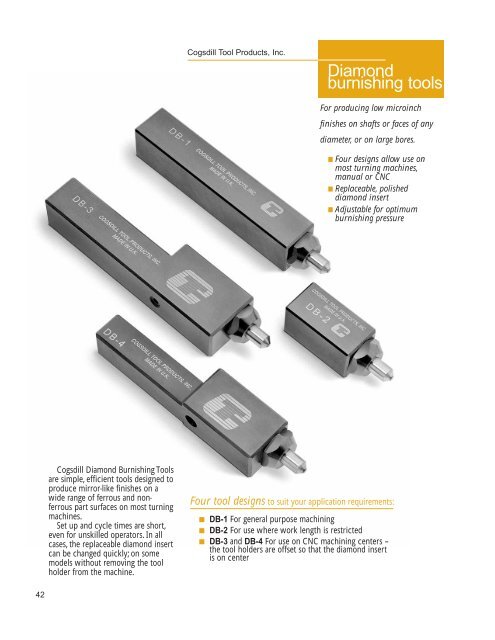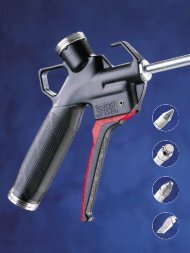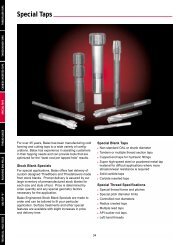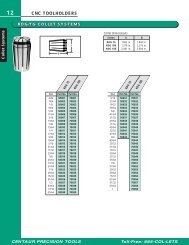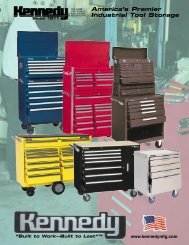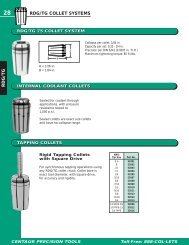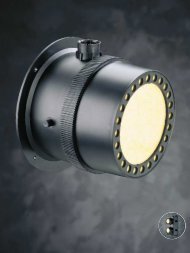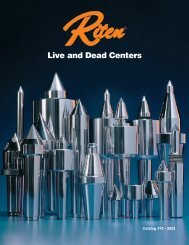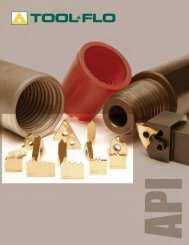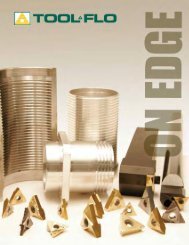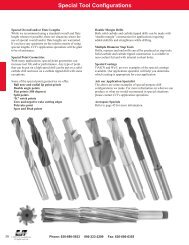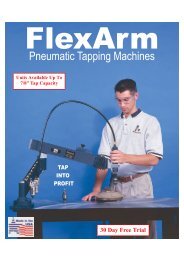Diamond burnishing tools
Diamond burnishing tools
Diamond burnishing tools
Create successful ePaper yourself
Turn your PDF publications into a flip-book with our unique Google optimized e-Paper software.
Cogsdill Tool Products, Inc.<br />
<strong>Diamond</strong><br />
<strong>burnishing</strong> <strong>tools</strong><br />
For producing low microinch<br />
finishes on shafts or faces of any<br />
diameter, or on large bores.<br />
■ Four designs allow use on<br />
most turning machines,<br />
manual or CNC<br />
■ Replaceable, polished<br />
diamond insert<br />
■ Adjustable for optimum<br />
<strong>burnishing</strong> pressure<br />
Cogsdill <strong>Diamond</strong> Burnishing Tools<br />
are simple, efficient <strong>tools</strong> designed to<br />
produce mirror-like finishes on a<br />
wide range of ferrous and nonferrous<br />
part surfaces on most turning<br />
machines.<br />
Set up and cycle times are short,<br />
even for unskilled operators. In all<br />
cases, the replaceable diamond insert<br />
can be changed quickly; on some<br />
models without removing the tool<br />
holder from the machine.<br />
Four tool designs to suit your application requirements:<br />
■ DB-1 For general purpose machining<br />
■ DB-2 For use where work length is restricted<br />
■ DB-3 and DB-4 For use on CNC machining centers –<br />
the tool holders are offset so that the diamond insert<br />
is on center<br />
42
<strong>Diamond</strong> <strong>burnishing</strong> <strong>tools</strong><br />
The Cogsdill <strong>Diamond</strong> Burnishing<br />
Tool is designed to produce high<br />
quality, low microinch burnished<br />
finishes on shafts, large bores, and<br />
faces.With most metals, a turned or<br />
ground part with a properly<br />
prepared 80 to 100 microinch finish<br />
can be burnished to a 4 to 8<br />
microinch finish in seconds. Cast iron<br />
can usually be burnished to an 8 to<br />
15 microinch finish.<br />
Cogsdill <strong>Diamond</strong> Burnishing Tools<br />
can burnish virtually any size stock;<br />
from carbon steels to tool steels, cast<br />
iron to alloys, and most ferrous and<br />
non-ferrous metals.The premium<br />
quality diamond <strong>burnishing</strong> insert is<br />
polished and contoured to provide<br />
superior finishes and excellent tool<br />
life.<br />
Since set up and operation is<br />
relatively simple, no special operator<br />
skills are required. <strong>Diamond</strong><br />
Burnishing Tools are versatile . . .<br />
various models are designed for use<br />
Replaceable<br />
diamond insert is<br />
polished and<br />
contoured for<br />
superior finishes<br />
and long tool life.<br />
in the tool post of a manual lathe,<br />
automatic, or in CNC equipment.The<br />
<strong>tools</strong> can be used on both large and<br />
small diameters, and are ideal for<br />
short production runs.The <strong>Diamond</strong><br />
Burnishing Tool can produce quality<br />
finishes on interrupted surfaces, such<br />
as a shaft with a keyway or the face<br />
of a flange having a series of bolt<br />
holes.<br />
While the tool must be used with<br />
coolant, no special coolant is<br />
required. Straight oils, soluble oils,<br />
and synthetic coolants can be used<br />
to provide the necessary lubrication.<br />
diamond<br />
<strong>burnishing</strong><br />
<strong>tools</strong><br />
43
How it works<br />
<strong>Diamond</strong> <strong>burnishing</strong> <strong>tools</strong><br />
The Cogsdill <strong>Diamond</strong> Burnishing<br />
Tool is mounted in the tool post of<br />
the desired machine.The diamond<br />
<strong>burnishing</strong> point is brought into<br />
contact with the workpiece at the<br />
centerline of the part and<br />
perpendicular to the surface being<br />
finished. The tool is then fed into the<br />
workpiece an additional .002 or .003<br />
inch (.05 or .08mm) to allow the<br />
diamond insert to become<br />
disengaged from the stop in the<br />
holder.The spring, with its preload,<br />
forces the diamond against the<br />
workpiece.The tool is then fed along<br />
the surface of the rotating workpiece<br />
to produce a mirrorlike finish.<br />
As a recommended starting point<br />
the adjusting screw should be<br />
tightened (turn clockwise) until all<br />
clearance between the push rod and<br />
the spring is removed.Then tighten<br />
the screw another 1 to 2 turns which<br />
will compress the spring to provide<br />
the necessary preload to the<br />
diamond insert.This is the<br />
recommended starting point for mild<br />
steel. Slight adjustments in the<br />
<strong>burnishing</strong> pressure can be made, if<br />
necessary, to achieve the optimum<br />
finish.To adjust the <strong>burnishing</strong><br />
pressure, tighten the adjustment<br />
screw to increase pressure or loosen<br />
the screw (turn counterclockwise) to<br />
reduce the pressure.<br />
The prefinish on most metals<br />
should be approximately 80 to 100<br />
R.M.S. for best results.A feed rate of<br />
.003 to .004 inches (.076 to .102mm)<br />
per revolution at speeds up to 750<br />
surface feet per minute (229 surface<br />
meters per minute) is generally<br />
recommended when using the<br />
Cogsdill <strong>Diamond</strong> Burnishing Tool.<br />
Normally, after the tool has been<br />
set to provide the .002 to .003 inch<br />
(.05 to .08mm) “interference”, it can<br />
be fed onto the rotating work-piece<br />
and allowed to feed off.The slight<br />
radius of the diamond tip is sufficient<br />
to cause the tool to “climb over” the<br />
edge of the part and begin its<br />
<strong>burnishing</strong> action. Likewise, if an<br />
interrupted surface is burnished,<br />
such as a shaft with a keyway or a<br />
flange with bolt holes, the tip of the<br />
tool will drop into the interruption<br />
but “climb up” the other edge due to<br />
the radius on the diamond.<br />
CAUTION: It is important NOT to<br />
exceed the recommended amount of<br />
interference.An excessive projection<br />
of the diamond insert into any<br />
surface interruption could cause tool<br />
breakage, as the diamond insert<br />
could not perform its “climbing”<br />
action. (Note:Adjustment of the<br />
<strong>burnishing</strong> force does not affect the<br />
amount of interference.)<br />
Note: <strong>Diamond</strong> <strong>burnishing</strong> <strong>tools</strong> do<br />
not have the advantage of an<br />
overlapping effect as with multi-roll<br />
<strong>tools</strong>, and for this reason slower<br />
feed rates and/or multiple passes<br />
over the part may be required in<br />
order to produce the desired finish.<br />
<strong>Diamond</strong> Burnishing Tools are adjustable for optimum <strong>burnishing</strong> pressure.<br />
For the DB-1 and DB-2 models, the adjustment screw is located in the end<br />
of the tool. For models DB-3 and DB-4, the adjustment screw is located on<br />
the side of the tool.<br />
44
Standard tool specifications<br />
<strong>Diamond</strong> <strong>burnishing</strong> <strong>tools</strong><br />
DB-1<br />
DB-2<br />
DB-3<br />
DB-4<br />
45
Cogsdill Tool Products, Inc.<br />
Universal TM<br />
<strong>burnishing</strong> <strong>tools</strong><br />
Two single-roll tool designs suitable<br />
for <strong>burnishing</strong> shafts, faces, tapers,<br />
contours, and large IDs (greater<br />
than 2.750 inches/69.85mm)<br />
■ Boring bar-style and indexable<br />
turning holder-style designs<br />
■ Low surface finishes<br />
■ Standard, available<br />
off-the-shelf<br />
■ Adjustable for optimum<br />
<strong>burnishing</strong> pressure<br />
■ Hardened steel or carbide<br />
rollers<br />
UBT-T indexable turning holder-style <strong>burnishing</strong> tool<br />
(Left-hand tool shown)<br />
UBT-B boring bar-style <strong>burnishing</strong> tool<br />
46
Universal TM <strong>burnishing</strong> <strong>tools</strong><br />
Versatility and roll options<br />
UBT-B <strong>burnishing</strong> O.D.<br />
UBT-B <strong>burnishing</strong> face<br />
ITEM NO.<br />
UBT-B-D03<br />
UBT-B-D19<br />
UBT-B-D16<br />
ROLLS FOR UBT-B TOOL<br />
ROLL TYPE & RADIUS<br />
HARDENED STEEL, .060 IN. (1.52MM)<br />
HARDENED STEEL, .030 IN. (0.76MM)<br />
CARBIDE, .060 IN. (1.52MM)<br />
ITEM NO.<br />
UBT-T-D03<br />
UBT-T-D03A<br />
UBT-T-D18<br />
ROLLS FOR UBT-T TOOL<br />
ROLL TYPE & RADIUS<br />
HARDENED STEEL, .093 IN. (2.36MM)<br />
HARDENED STEEL, .030 IN. (0.76MM)<br />
CARBIDE, .093 IN. (2.36MM)<br />
UBT-T <strong>burnishing</strong> taper<br />
(Left-hand tool shown)<br />
rolls<br />
47
Operating instructions<br />
Universal TM <strong>burnishing</strong> <strong>tools</strong><br />
Operating<br />
instructions for<br />
UBT-B Universal<br />
Burnishing Tool TM<br />
Loosen the load adjusting screws<br />
(detail 13) until they project<br />
approximately 1/8 inch (3.17mm)<br />
from the shank (detail 9).Tighten the<br />
screws until they contact the<br />
Belleville springs. Continue to tighten<br />
1/2 turn past snug. This is a<br />
recommended starting point for mild<br />
steel.<br />
Adjustment can be made to the<br />
<strong>burnishing</strong> force to achieve optimum<br />
finish.Tighten the load adjusting<br />
screws clockwise to increase<br />
<strong>burnishing</strong> force or counterclockwise<br />
to lessen the force.<br />
Mount the UBT-B in the desired<br />
boring bar station. The grease<br />
fitting should be opposite<br />
the contact point. Bring the<br />
tool into contact with the part to be<br />
burnished. Feed the tool another<br />
.003-.005 inch (.08 to .13mm) into<br />
the part to provide interference<br />
between the roll and part so that the<br />
roll will float in its spring travel.<br />
Interference should not be used to<br />
increase <strong>burnishing</strong> force. Only<br />
adjust the <strong>burnishing</strong> force with the<br />
load adjusting screws. This insures<br />
the tool can be fed on/off the part<br />
and across interruptions without<br />
damage to the tool or workpiece.<br />
Burnish the part, using coolant or<br />
oil, at a speed of 750 surface feet per<br />
minute (229 surface meters per<br />
minute) with a feed rate of .001 to<br />
.006 IPR (.02 to .15mm/rev.).<br />
Examine finish and adjust tool if<br />
needed.Whenever possible and for<br />
best results the tool should be fed<br />
towards the spindle when <strong>burnishing</strong><br />
on diameters and towards<br />
the centerline when<br />
<strong>burnishing</strong> faces.<br />
Operating<br />
instructions for<br />
UBT-T Universal<br />
Burnishing Tool TM<br />
Loosen the load adjusting screw<br />
(detail 14) until it projects<br />
approximately 1/8 inch (3.17mm)<br />
from the housing (detail 2). Tighten<br />
the screw until it contacts the<br />
Belleville springs. Continue to tighten<br />
1/2 turn past snug. This is the<br />
recommended starting point for mild<br />
steel.<br />
Adjustment can be made to the<br />
<strong>burnishing</strong> force to achieve optimum<br />
finish.Tighten the load adjusting<br />
screw clockwise to increase<br />
<strong>burnishing</strong> force or counterclockwise<br />
to lessen the force.<br />
Roll orientation is adjustable in<br />
45˚ increments. Set the roll to<br />
desired orientation and mount the<br />
tool in the machine. Bring the tool<br />
into contact with the part on<br />
centerline to the surface to be<br />
burnished. Feed the tool another<br />
.003-.005 inch (.08 to .13mm) into<br />
the part to provide interference<br />
between the roll and part so the roll<br />
will float in its spring travel.<br />
Interference should not be used to<br />
increase <strong>burnishing</strong> force. Only<br />
adjust the <strong>burnishing</strong> force with the<br />
load adjusting screw. This insures the<br />
tool can be fed on or off the part and<br />
across interruptions without damage<br />
to the tool or workpiece.<br />
Burnish the part, using coolant or<br />
oil, at a speed of 750<br />
surface feet per<br />
minute (229 surface<br />
meters per minute)<br />
with a feed rate of<br />
.001- .006 IPR (.02<br />
to .15mm/rev.).<br />
Examine finish and<br />
adjust tool if<br />
needed.<br />
NOTE: For both the UBT-B and the<br />
UBT-T <strong>tools</strong>, coolant is required in<br />
order to achieve optimum results<br />
and long tool life. Any soluble,<br />
synthetic, or straight oils can be<br />
used. Single-roll <strong>tools</strong> do not have<br />
the advantage of an overlapping<br />
effect as with multi-roll <strong>tools</strong>, and<br />
for this reason slower feed rates<br />
and/or multiple passes over the<br />
part may be required in order to<br />
produce the desired finish.<br />
48
Standard tool specifications<br />
Universal TM <strong>burnishing</strong> <strong>tools</strong><br />
UBT-B<br />
UBT-T<br />
RIGHT<br />
UBT-T<br />
LEFT<br />
49
Cogsdill Tool Products, Inc.<br />
Roll-a-Finish tool<br />
KB ® knurling<br />
<strong>tools</strong><br />
Salvage out-of-tolerance bores or<br />
shafts with the two-step KB ®<br />
Knurling-Burnishing<br />
“scrap saver” process.<br />
Worthless scrap or precision part<br />
The KB “Scrap-Saver” process can<br />
make the difference.<br />
Cogsdill’s KB process is an<br />
innovative approach to making the<br />
diameter of holes smaller and the<br />
diameter of shafts larger.The KB<br />
process was originally developed for<br />
automotive parts rebuilding<br />
industries, where out-of-tolerance<br />
bores and shafts on parts that were<br />
formerly scrapped are salvaged with<br />
the KB process.The process is also<br />
applied in original equipment<br />
manufacturing.<br />
KB knurling tool<br />
50
The KB process<br />
KB ® knurling <strong>tools</strong><br />
KB is Superior to<br />
Conventional<br />
Salvage Methods<br />
Conventional salvage methods,<br />
including spray welding and chrome<br />
plating, are expensive, timeconsuming,<br />
and often produce<br />
unsatisfactory results. These metaladding<br />
processes do not deposit a<br />
uniform thickness around the<br />
circumference of the hole or shaft;<br />
they also deposit metal where it is<br />
not wanted, and remachining is<br />
required. Often remachining is<br />
difficult because no qualified-surfaces<br />
are available for alignment.<br />
Another approach is to cut away<br />
additional metal and install a bushing<br />
or sleeve. Additional time and effort<br />
is required for machining and<br />
finishing the part to bring it within<br />
tolerance.<br />
The KB Process eliminates these<br />
problems in two quick steps through<br />
the use of two <strong>tools</strong>. The KB<br />
Knurling Tool raises the surface of<br />
the oversize bore (or undersize<br />
How it works<br />
shaft). The Roll-a-Finish Tool roller<br />
burnishes the knurled surface to the<br />
exact diameter required. (See below,<br />
“How It Works.”) The entire two-step<br />
process can be accomplished in<br />
seconds<br />
Improved surface<br />
characteristics and<br />
lower cost<br />
In addition to the benefits of<br />
Knurling/Burnishing as a sizing and<br />
salvage method, the process results<br />
in a series of plateaus on the same<br />
plane in the surface of the metal,<br />
thus providing increased contact<br />
area. Tests by a major auto<br />
manufacturer have shown increases<br />
in surface holding power of up to<br />
35% over surfaces which are<br />
precision bored to receive press-fit<br />
bearings. In many cases the finished<br />
boring process may be eliminated<br />
altogether. The grooves in the<br />
Knurled/Burnished surface are ideally<br />
suited for use with an adhesive<br />
agent. The grooves are also desirable<br />
for the effect of trapping and<br />
funneling away foreign matter and<br />
grit that might otherwise remain on<br />
the bearing surface of the part.<br />
For running fits, the increased<br />
contact area diminishes the load<br />
carried at any given point on the part<br />
surface; this increases the ability of<br />
the surface to resist wear. Knurling,<br />
like Roller Burnishing, is a metal<br />
displacement process, and the workhardening<br />
effect of the <strong>tools</strong> also<br />
contributes to the ability of the<br />
Knurled/Burnished surface to resist<br />
wear.<br />
The KB Process can result in cost<br />
savings in several areas. Machine<br />
time can be reduced as much as-10:1.<br />
Substantial reductions are achieved<br />
in tool cost and tool inventory.<br />
Fewer machines and less floor space<br />
are required.<br />
Knurling and Burnishing makes<br />
holding size easier; this results in<br />
savings in inspection time and scrap.<br />
Oversize Bore 1 Knurl to 2 Burnish to<br />
raise surface<br />
correct size<br />
Oversize Bore 1 Knurl to 2 Burnish to<br />
raise surface<br />
correct size<br />
2<br />
Out of tolerance<br />
Surface as machined Knurled to raise surface Burnished to correct size<br />
An oversize bore may be machined out-oftolerance<br />
or made oversize by excessive<br />
wear. Here’s how the KB Process can salvage<br />
this part:<br />
steps<br />
1 — A Cogsdill KB Knurling<br />
Tool displaces material on<br />
the oversize hole diameter,<br />
raising the surface as much<br />
as .030 inch (.76mm) in a<br />
diamond-shaped knurled<br />
pattern.The bore is now<br />
undersize.<br />
2 — A Cogsdill Roll-a-Finish<br />
Tool cold works the knurled<br />
surface, <strong>burnishing</strong> the hole<br />
to correct size.<br />
51
The KB process<br />
KB ® knurling <strong>tools</strong><br />
Tool operation<br />
Knurling may be performed with<br />
either the tool or the part rotating.<br />
Any ductile or malleable metal may<br />
be knurled including aluminum,<br />
brass, bronze, ductile iron, steels (up<br />
to 40 Rc) and cast iron (except<br />
chilled and white cast). Speeds<br />
should approximate drilling speeds,<br />
and feed rate starting points can be<br />
determined from the table below.<br />
Although hand-fed operations are<br />
possible on many machines, power<br />
feeding is desirable to obtain a more<br />
uniform knurl pattern. Return feeds<br />
may be two to three times the infeed<br />
rate.<br />
The operations should be<br />
performed under a flood of coolant.<br />
A water soluble, high-lubricity oil is<br />
recommended. If coolant cannot be<br />
used, speeds and feeds should be<br />
reduced by two-thirds to ensure<br />
reasonable knurl and pin life.<br />
Once the <strong>tools</strong> are set for size, an<br />
unskilled operator can obtain<br />
consistently good results, even over<br />
long work lengths.<br />
Cogsdill knurling <strong>tools</strong> do not<br />
require accurate location, and in<br />
most cases it is recommended to<br />
have either the tool or part free to<br />
float. Each knurling roll depends on<br />
the support of the opposing roll to<br />
do its work; therefore, the <strong>tools</strong> are<br />
self-centering.<br />
Typical changes in workpiece<br />
diameter, after knurling with medium<br />
pitch knurling rolls (20 teeth per<br />
circular inch), are as follows: for cast<br />
iron, .006 inch (.15mm); for steel,<br />
.008 inch (.2mm); for bronze, .010<br />
inch (.25mm); and for aluminum,<br />
.012 inch (.30mm).<br />
MATERIAL SPEED FEED RATE<br />
SFPM SM/MIN. IPR MM/REV<br />
Aluminum or brass 200-300 61-91 .030 .76<br />
Leaded steel 125-150 38--46 .030 .76<br />
Soft cast iron carbon steel 80-120 24-37 .018 .46<br />
# 50 cast iron, medium alloy steel 60-90 18-27 .012 .30<br />
# 65 cast iron, alloy steel (35-40 R/C) 25-35 8-11 .008 .20<br />
Knurling rolls<br />
Worn knurling rolls should be<br />
replaced in sets, However, if a<br />
knurling roll should be damaged, it<br />
may be replaced by a new roll of like<br />
hand.<br />
KN-1 and KN-2 knurling rolls are<br />
stocked in medium and coarse pitch;<br />
KN-3 rolls are stocked in medium<br />
pitch only. (Medium is 20 teeth per<br />
circular inch, and coarse is 14 teeth<br />
per circular inch.) Please specify<br />
medium or coarse pitch when<br />
ordering. Standard knurling rolls have<br />
knurls set at a 45 degree angle.<br />
Special angles and pitches are<br />
available on special order.<br />
Cogsdill Knurling Tools require<br />
an equal number of left and<br />
right hand knurling rolls,<br />
placed in opposing stations.<br />
Special <strong>tools</strong><br />
Special Knurling Tools, including<br />
external <strong>tools</strong>, <strong>tools</strong> for larger<br />
diameters, and fully-bottoming <strong>tools</strong>,<br />
are available on special order.When<br />
requesting a quotation for a special<br />
tool, please furnish the following data:<br />
1. Part description and part number<br />
(if any).<br />
2. A blueprint or sketch of your part.<br />
3 . Exactly what job is to be<br />
performed; i.e. what particular<br />
surface of the part is to be knurled.<br />
4. Material type and hardness.<br />
5. If a salvage job is to be performed,<br />
advise how much parts are<br />
oversized or undersized.<br />
6. Tolerance requirements.<br />
7. Shank requirements.<br />
52
Tool design<br />
Standard Cogsdill Knurling Tools<br />
are available for internal applications.<br />
External <strong>tools</strong> are available on special<br />
order (see “Special Tools”).All<br />
standard internal Knurling Tools are<br />
of similar design with differences<br />
only in the number of knurling rolls<br />
and the diameter adjustment<br />
mechanism.<br />
Small <strong>tools</strong> from KBN-625 through<br />
KBN-1156 are adjusted by turning a<br />
hex-head screw in the side of the<br />
tool.Tools in this range have two<br />
rolls.<br />
The larger internal <strong>tools</strong> are<br />
adjusted by means of a hex-head<br />
screw through the center of the tool.<br />
The screw is accessible from the<br />
front of the tool.<br />
Tools from KBN-1188 through<br />
KBN-2926 have four knurling rolls,<br />
while those from KBN-3000 through<br />
KBN-4000 have six knurling rolls.<br />
All internal Knurling Tools are<br />
adjustable over a range of .041 inch,<br />
as are Cogsdill Roll-a-Finish <strong>tools</strong>.<br />
The tool consists of shank, rolls,<br />
pins and adjusting screw. Morse taper<br />
shanks are standard.The rolls and<br />
pins are the only items considered<br />
wear parts; these are available from<br />
stock.We recommend that at least<br />
one spare set of rolls and pins is<br />
ordered when a knurling tool is<br />
purchased.The pins are retained by a<br />
set screw and can be easily removed<br />
when it is necessary to replace worn<br />
rolls.<br />
All standard <strong>tools</strong> are designed for<br />
through-hole applications.These<br />
<strong>tools</strong> can also be used on semibottoming<br />
applications; the tool will<br />
work to .080 inch (2.03mm) from<br />
the bottom of the bore. Bottoming<br />
<strong>tools</strong> are also available, on special<br />
order (see “Special Tools”).<br />
knurling<br />
KB ® knurling <strong>tools</strong><br />
designtool<br />
53
KB ® knurling <strong>tools</strong><br />
Standard tool specifications<br />
Diameter Range Overall Length Pins & Knurls<br />
Tool No. Inches Millimeters Shank Inches MM Size Qty. Req.<br />
KBN-625 .621-.662 15.77-16.81<br />
KBN-656 .652-.693 16.56-17.60 #KN-3<br />
KBN-688 .684-.725 17.37-18.42 (.312 Inch<br />
KBN-719 .715-.756 18.16-19.20 Dia.)<br />
KBN-750 .746-.787 18.95-19.99<br />
KBN-781 .777-.818 19.74-20.78<br />
KBN-812 .808-.849 20.52-21.56<br />
KBN-844 .840-.881 21.34-22.38<br />
KBN-875 .871-.912 22.12-23.16 2<br />
KBN-906 .902-.943 22.91-23.95<br />
KBN-938 .934-.975 23.72-24.77<br />
KBN-969 .965-1.006 24.51-25.55<br />
KBN-1000 .996-1.037 25.30-26.34<br />
KBN-1031 1.027-1.068 26.09-27.13<br />
KBN-1062 1.058-1.099 26.87-27.91<br />
KBN-1094 1.090-1.131 27.69-28.73<br />
KBN-1125 1.121-1.162 28.47-29.51 #2MT 6.75 171.4<br />
KBN-1156 1.152-1.193 29.26-30.30<br />
KBN-1188 1.184-1.225 30.07-31.12<br />
KBN-1219 1.215-1.256 30.86-31.90<br />
KBN-1250 1.246-1.287 31.65-32.69<br />
KBN-1281 1.277-1.318 32.44-33.48<br />
KBN-1312 1.308-1.349 33.22-34.26<br />
KBN-1344 1.340-1.381 30.04-35.08 #KN-2<br />
KBN-1375 1.371-1.412 34.82-35.86 (.375 Inch<br />
KBN-1406 1.402-1.443 35.61-36.65 Dia.)<br />
KBN-1438 1.434-1.475 36.42-37.47<br />
KBN-1469 1.465-1.506 37.21-38.25<br />
KBN-1500 1.496-1.537 38.00-39.04<br />
KBN-1531 1.527-1.568 38.79-39.83<br />
KBN-1562 1.558-1.599 39.57-40.61 4<br />
KBN-1594 1.590-1.631 40.39-41.43<br />
KBN-1625 1.621-1.662 41.17-42.21<br />
KBN-1656 1.652.-1.693 41.96-43.00<br />
KBN-1688 1.684-1.725 42.77-43.82<br />
KBN-1719 1.715-1.756 43.56-44.60<br />
KBN-1750 1.746-1.787 44.35-45.39<br />
KBN-1781 1.777-1.818 45.14-46.18<br />
KBN-1812 1.808-18.49 45.92-46.96<br />
KBN-1844 1.840-1.881 46.74-47.78<br />
KBN-1875 1.871-1.912 47.52-48.56<br />
KBN-1906 1.902-1.943 48.31-49.35<br />
KBN-1938 1.934-1.975 49.12-50.17<br />
KBN-1969 1.965-2.006 49.91-50.95 #3MT 7.75 196.8<br />
KBN-2000 1.996-2.037 50.70-51.74<br />
KBN-2031 2.027-2.068 51.49-52.53<br />
KBN-2062 2.058-2.099 52.27-53.31 #KN-1<br />
KBN-2094 2.090-2.131 53.09-54.13 (.750 Inch<br />
KBN-2125 2.121-2.162 53.87-54.91 Dia.)<br />
KBN-2156 2.152-2.193 54.66-55.70<br />
KBN-2188 2.184-2.225 55.47-56.52<br />
KBN-2219 2.215-2.256 56.26-57.30<br />
KBN-2250 2.246-2.287 57.05-58.09<br />
KBN-2281 2.277-2.318 57.84-58.88<br />
KBN-2312 2.308-2.349 58.62-59.66<br />
54
KB ® knurling <strong>tools</strong><br />
Standard tool specifications<br />
Diameter Range Overall Length Pins & Knurls<br />
Tool No. Inches Millimeters Shank Inches MM Size Qty. Req.<br />
KBN-2344 2.340-2.381 59.44-60.48<br />
KBN-2375 2.371-2.412 60.22-61.26<br />
KBN-2406 2.402-2.443 61.01-62.05<br />
KBN-2438 2.434-2.475 61.82-62.87<br />
KBN-2469 2.465-2.506 62.61-63.65<br />
KBN-2500 2.496-2.537 63.40-64.44<br />
KBN-2531 2.527-2.568 64.19-65.23<br />
KBN-2562 2.558-2.599 64.97-66.01<br />
KBN-2594 2.590-2.631 65.79-66.83<br />
KBN-2625 2.621-2.662 66.57-67.61 #3MT 7.75 196.8 4<br />
KBN-2656 2.652-2.693 67.36-68.40<br />
KBN-2688 2.684-2.725 68.17-69.22<br />
KBN-2719 2.715-2.715 68.96-70.00<br />
KBN-2750 2.746-2.787 69.75-70.79<br />
KBN-2781 2.777-2.818 70.54-71.58<br />
KBN-2812 2.808-2.849 71.32-72.36<br />
KBN-2844 2.840-2.881 72.14-73.18<br />
KBN-2875 2.871-2.912 71.92-73.96<br />
KBN-2906 2.902-2.943 73.71-74.75<br />
KBN-2938 2.934-2.975 74.52-75.57<br />
KBN-2969 2.965-3.006 75.31-76.35<br />
KBN-3000 2.996-3.037 76.10-77.14<br />
KBN-3031 3.027-3.068 76.89-77.93<br />
KBN-3062 3.058-3.099 77.67-78.71<br />
KBN-3094 3.090-3.131 78.49-79.53<br />
KBN-3125 3.121-3.162 79.27-80.31<br />
KBN-3156 3.152-3.193 80.06-81.10<br />
KBN-3188 3.184-3.225 80.87-81.92<br />
KBN-3219 3.215-3.256 81.66-82.70 #KN-1<br />
KBN-3250 3.246-3.287 82.45-83.49 (.750 Inch<br />
KBN-3281 3.277-3.318 83.24-84.28 Dia.)<br />
KBN-3312 3.308-3.349 84.02-85.06<br />
KBN-3344 3.340-3.381 84.84-85.88<br />
KBN-3375 3.371-3.412 85.62-86.66<br />
KBN-3406 3.402-3.443 86.41-87.45<br />
KBN-3438 3.434-3.475 87.22-88.27<br />
KBN-3469 3.465-3.506 88.01-89.05 #4MT 8.75 222.2 6<br />
KBN-3500 3.496-3.537 88.80-89.84<br />
KBN-3531 3.527-3.568 89.59-90.63<br />
KBN-3562 3.558-3.599 90.37-91.41<br />
KBN-3594 3.590-3.631 91.19-92.23<br />
KBN-3625 3.621-3.662 91.97-93.01<br />
KBN-3656 3.652-3.693 92.73-93.80<br />
KBN-3688 3.684-3.725 93.57-94.62<br />
KBN-3719 3.715-3.756 94.36-95.40<br />
KBN-3750 3.746-3.787 95.15-96.19<br />
KBN-3781 3.777-3.818 95.94-96.98<br />
KBN-3812 3.808-3.849 96.72-97.76<br />
KBN-3844 3.840-3.881 97.54-98.58<br />
KBN-3875 3.871-3.912 98.32-99.36<br />
KBN-3906 3.902-3.943 99.11-100.15<br />
KBN-3938 3.934-3.975 99.92-100.97<br />
KBN-3969 3.965-4.006 100.71-100.97<br />
KBN-4000 3.996-4.037 101.50-102.54<br />
55
COGSDILL TOOL<br />
procucts, inc.<br />
PLEASE<br />
PHOTOCOPY<br />
CUSTOMER__________________________________________________________ DATE____________________________ & COMPLETE<br />
THIS FORM &<br />
ADDRESS_____________________________________________________________________________________________<br />
ENCLOSE<br />
CITY______________________________________________ STATE____________________ ZIP_____________________ WITH YOUR<br />
ORDER OR<br />
CONTACT______________________________________________ TELEPHONE___________________________________ REQUEST FOR<br />
QUOTATION.<br />
FAX___________________________________________ E-MAIL ADDRESS_______________________________________<br />
THE DATA<br />
TITLE________________________________________________________________________________________________ WILL BE USED<br />
TO ENSURE<br />
SALES AGENT_______________________________________ SALESMAN________________________________________ THAT THE<br />
CUSTOMER’S PART____________________________________________________________________________________ CORRECT<br />
TOOL IS<br />
PRINTS INCLUDED YES______ NO_______ LATER_______<br />
FURNISHED<br />
FOR YOUR<br />
PRIMARY OBJECTIVE SIZE_______ FINISH_______ OTHER_____________________________________________<br />
PARTICULAR<br />
THROUGH-HOLE OR BLIND BORE _______________________________________________________________________ APPLICATION.<br />
FINISH DIAMETER(S)________________________________ TOLERANCE(S)_____________________________________<br />
SURFACE FINISH REQUIRED______________ in Ra<br />
WHAT IS THE OPERATION PRIOR TO BURNISHING________________________________________________________<br />
_____________________________________________________________________________________________________<br />
PRESIZE(S)_________________________________ TOLERANCE(S)_____________________________________________<br />
PREFINISH________________________________ in Ra<br />
LENGTH OF BURNISH________________________ MATERIAL________________________________________________<br />
MATERIAL CONDITION (HARDNESS OR TENSILE STRENGTH)________________________________________________<br />
TYPE OF MACHINE TO BE USED_____________________ TYPE SHANK________________________________________<br />
EXTERNAL OR INTERNAL COOLANT ___________________________________________________________________<br />
IS THE TOOL TO BE RUN HORIZONTALLY OR VERTICALLY ________________________________________________<br />
AUTOMATIC TOOL CHANGER YES _____ NO _____<br />
WEIGHT RESTRICTION ______________________________<br />
TOOL LENGTH RESTRICTION ________________________<br />
ARE THERE RESTRICTIONS ON DIAMETER OR LENGTH (FIXTURE INTERFERENCE, SHOULDER, GROOVE, KEYWAY, ETC.)<br />
_____________________________________________________________________________________________________<br />
_____________________________________________________________________________________________________<br />
PRODUCTION REQUIREMENT___________________________________________________________________________<br />
_____________________________________________________________________________________________________<br />
ADDITIONAL COMMENTS_______________________________________________________________________________<br />
______________________________________________________________________________________________________<br />
______________________________________________________________________________________________________<br />
Fax or mail to:<br />
FAX (803) 438-5263<br />
Cogsdill Tool Products, Inc.<br />
P.O. Box 7007<br />
Camden, SC 29020<br />
ATTN: CUSTOMER SERVICE<br />
Application data sheet<br />
Roller <strong>burnishing</strong> <strong>tools</strong><br />
IMPORTANT<br />
PART PRINT OR<br />
DETAILED SKETCH<br />
MUST BE SUPPLIED.


